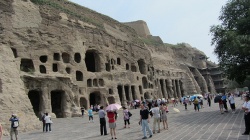School (Pitanzong 毘曇宗)
The term Pitanzong is used as a common designation of the Chinese form of the Sarvāstivāda School (Youbu 有部). The different treatises of this Indian school of "higher teaching" was unified in the treatise Fazhilun 發智論 (T 1544), written by "Qieduoyannizi迦多衍尼子" and translated by the great Xuanzang 玄奘. A treatise contrasting with the Fazhilun is Da pi posha lun 大毘婆沙論 (T 1545). Various interpretations were harmonized in the sutra Za apitan xin lun 雜阿毘曇心論 (T 1552). The Abhidharma School was one of the first Buddhist Schools founding monasteries and Buddhist communities in China, and missionaries used the translations made by the Parthian An Shigao 安世高. It was only during the reign of the "barbarian" Fu Jian 苻建 in the 4th century that Abhidharma Buddhism was thought in a systematic way under the guidance of Dao'an 道安. After the collapse of this Former Qin empire, Abhidharma monks moved to the south where they spread their teachings among the Buddhist sanghas on Mt. Lushan 廬山 and at the court of the Southern Dynasties. After the begin of the Tang period, monks payed little attention to the Abhidharma writings that became gradually replaced by other influential schools, a fact that can be deducted from the non-patriarchal organization of the Abhidharma teachers who were never unified by a founding monastery. According to Abdhidharma teaching, the four truths (sidi 四諦) – being the only absolute principle in a void world – constitute all different dharmas (fa 法; appearings of the sentient beings). The self is void, there is no self, and every dharma or variable (Sanskr. skandha; yun 蘊) of the self is the causation of former lifes. Within a world where all determinants like shape, color, character etc. are purely virtual and not absolute, there is only one steady and non-relative principle that will never change, i.e. the teaching of the Buddha, and the fact that there is a past and a future for every being ("three worlds" sanshi 三世). Because the treatises of the Abhidharma School were fundamental for the metaphysical explanation of life, they constitute an own department in the Pali Canon (Abhidammapittaka). The greatest Indian teacher of the "higher subtleties" was Vasubandhu (Chin. Shiqin 世親) who wrote the treatise Abhidharmakośa-bhāsya (Chin. Jushelun 倶舍論; T 1558). Consciousness-only School (Weishizong 唯識宗)
Together with the School of the Middle Path, the Consciousness-Only School (Weishizong 唯識宗), also called Dharma Character School (Faxiangzong 法相宗) or Idealistic School, is one of the two great Indian Mahāyāna schools. The Vijñānavāda or Yogācāra School (Chin. Yuqie 瑜伽) were founded by Asanga and Vasubandhu (both 4th cent. AD) and transformed into the Shelun 攝論 or Weiyi School by the great translator Xuanzang 玄奘 (d. 664) who compiled a systematic treatise about the Indian idealists (Cheng weishi lun 成唯識論; T 1585) Vinaya School (Lüzong 律宗)
